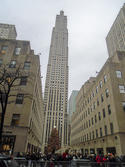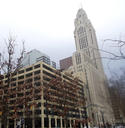The Partnership for New York City polled its members in the last month and found that, as of early March, 10% of Manhattan office workers who were working remotely (generally working at home) had returned to the office. This is unchanged from October. The purpose of the survey was to project future shares of working in the office and working at home in the nation’s largest central business district (CBD). read more »
New York
Why More Americans Should Leave Home and Move to Other States
America has been lazily divided by pundits into red and blue states, as if there weren’t constant movement of people between them. Fortunately, reality is a lot more purple — and hopeful — as immigrants, people of color and millennials reshape parts of America by voting with their feet and moving.
These demographic groups are migrating from the big coastal cities to the suburbs, the interior cities, the South and even parts of the Midwest. And in the process, these newcomers change both their new homes and are also changed by them. read more »
- Login to post comments
The New American Judaism
Ever since God chased Adam and Eve from Paradise, the Jewish experience has been defined by constant movement. In the past 3,000 years Jews shifted from a small sect escaping exile in Egypt to a national Temple-based model, then to a Talmudic diaspora, hunkered down in European ghettos and shtetls. That was followed by waves of migration at the turn of the 20th century that inaugurated a new promised land in America and over 100 years of Jewish American advancement organized around what became a lavish institutional Judaism. read more »
New York Again Seeks a Handle Up
One aspect of New York City’s clean-up in the 1990s was the closing of many dingy Off-Track Betting parlors. Some tidier operations lived on for a few years but ultimately Gotham said good riddance to the public gambling-on-horses corporation. read more »
- Login to post comments
Work Trips in the CSAs with the Largest CBDs
This article describes the reduction in work visits, by counties within the six combined statistical areas (CSAs), also called commuting zones, that include the nation’s six largest downtown areas (central business districts, or CBDs) by employment. CSAs are combinations of adjacent metropolitan and micropolitan areas that have strong work trip commuting connections, but not as strong as within metropolitan areas (MSAs). read more »
- Login to post comments
California and Urban Cores Dominate Overcrowded Housing
Concern about overcrowded housing has been heightened by its association with greater COVID-19 infection risk. As a disease transmitted by human proximity, exposure is increased by being in overcrowded and insufficiently ventilated spaces where sufficient social distancing is not possible. Exposure density for a person is intensified by the amount of time spent in such circumstances. read more »
- Login to post comments
Post-Pandemic Housing Reality, Alt Cities to CA-NYC Housing Boom
A crazy week with a *ton* of new items I'll only be able to partially get through in this post, including some followups to last week's post about California tech companies moving to Texas: read more »
- Login to post comments
'The Hamptons' is a One-Industry Place
A “resort” community where there is no central commercial resort can still be a one-industry economy. In the case of the South Fork of Long Island (aka “Hamptons”), the one trick is luxury housing. There’s an extensive commercial/labor ecosystem to support it. read more »
- Login to post comments
Latest Data Shows Pre-Pandemic Suburban/Exurban Population Gains
The latest complete American Community Survey (ACS) data, analyzed by the Demographia City Sector Model, indicates that population growth in the nation’s 53 major metropolitan areas (over 1,000,000 residents) continues to be, even before the pandemic, overwhelmingly suburban and exurban. read more »
- Login to post comments
The Big Moves: Where People Are Moving
For decades, New York has been the leading exporter of people to other states, though has been severely challenged since 2000 by California. During five years around the housing bust, more net domestic migrants left California than New York. Then, for a time, California’s annual losses were not quite as severe read more »
- Login to post comments






















